This is one of those "just watch it" ones…
Monthly Archives: April 2013
Taking a Leak…
Fox News is up in arms over a threatened jail sentence for reporter Jana Winter who is refusing to reveal her source for the notebook of "alleged Aurora shooter" James Holmes. (I put quotes around that because even his defense isn't claiming he wasn't the shooter there; just that he was insane.)
Anyway, the author of this article is right that Winter should not face time behind bars if she won't reveal her source…
From Woodward and Bernstein, who met with a mysterious source named Deep Throat in a garage, to a local zoning board official who is privy to municipal corruption in a small town, conversations between journalists and unnamed sources lead to investigative articles that shed light on the very things those in power would rather not reveal. Off the record conversations — or "leaks," as they may be less pleasantly called — are the bricks and mortar of what you read when you crack open a newspaper.
Absolutely right except that Bernstein never met with Deep Throat. But true, our news media cannot function if reporters can't guarantee anonymity to most kinds of sources. Still, I can't help but react to this…
Imagine if a judge had forced Bob Woodward and Carl Bernstein to reveal the identity of Deep Throat, who corroborated so much of their research into the Watergate scandal. Mark Felt, the associate director at the FBI, would likely never have risked his career, his family's safety and the opprobrium that came with notoriety to leak information to the Washington Post. The arc of history would therefore have been very different indeed.
That's also true but I seem to remember that when Mr. Felt's identity was finally revealed, a certain "alleged news channel" was flooded with its contributors saying that Felt was a coward for leaking what he leaked, that his motives were impure and I think the word "treason" was even employed. A lot of that opprobrium came from Fox News.
Dept. of Additional Information
Many folks are reminding this A.M. of Joe Flynn's other big voice credit in animation — Mr. Snoops in the 1977 Disney film, The Rescuers. He was pretty good in that. He was actually a pretty funny actor. Not long before he passed (in '74), he became a regular on the talk show circuit. Johnny Carson first had him on as a guest in June of '72 and I seem to recall Mr. Flynn saying it was the first time he'd ever done anything like that. I do recall that he was hilarious and that you could see that "we've gotta have this guy on a lot" look on Johnny's face. And indeed, health permitting, Flynn appeared once a month with Carson thereafter and started doing Merv as well.
Brent Seguine, who knows everything worth knowing about the Stooges, says that I'm wrong about that male person in the "Swinging the Alphabet" number in Violent is the Word for Curly. It's not an outta-place male student. It's actor Eddie Fetherston playing one of the school officials. He was introduced earlier in the film. I was so busy taking voluminous notes that I missed that.
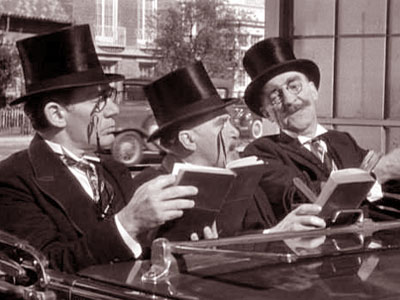
Brent also writes about the film's three visiting professors. The one on the left is Al Thompson. The one in the middle is Alex Novinsky. Who's the guy at the right? Stooge Experts everywhere are tearing their hair out and poking one another in the eyes trying to find this guy's name…and he also played Professor Tuttle one year later in the knuckleheads' We Want Our Mummy. If you have any leads, send them to me and I'll pass them on to Brent.
Also, Derek Tague notes that in Violent is the Word for Curly, Curly is introduced to the class as Professor Von Stupid. "How then," he wonders, "are the co-eds able to address him as Curly when they sing 'Curly's a dope!' just before the instrumental finale?" How, indeed? It's just this kind of shoddy writing that makes it hard for some people to take a Three Stooges film seriously.
You Plug One Friend's Book…
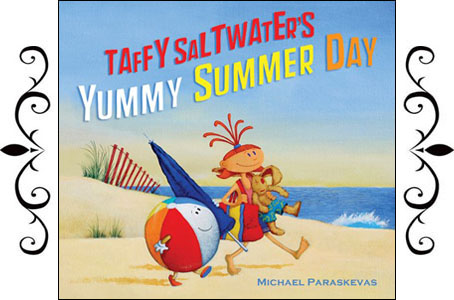
…you gotta plug them all. This'll be the last one for a while but in this case, it's a wholehearted plug. My pal Michael "Mickey" Paraskevas draws as well as anyone I know — and I know a lot of terrific artists. Every year or three, he paints the hell out of a new book for kids and a sweet story turns into something very special for children of all ages.
Tomorrow is the release date for Taffy Saltwater's Yummy Summer Day, which he did last year while visiting Los Angeles, which he does largely to hang out with me at Farmers Market and eat hot turkey sandwiches. It's really, really good. If you need to buy a gift for a youngster, trust me: They'll love this story. That is, if you can bring yourself to actually give them the damned thing and stop looking at the neat illustrations yourself. Better order two copies. And if you don't trust me, check out the preview on Amazon and trust your own eyes.
Hairy History

Speaking of Hanna-Barbera as one of us was: Our pal Greg Ehbrar has a nice piece up at Cartoon Research about Help! It's the Hair Bear Bunch, a 1971 Saturday morning cartoon that represented one of the better shows of that period. It was another in the unending series of H-B programs about one or more animal characters sneaking out a place of imprisonment — a zoo, a park, an aquarium, etc. In this case, it was three bears in a zoo and their leader, Hair Bear — the one with the Phil Spector hair-do — was voiced by Daws Butler. Not every Hanna-Barbera show with Daws Butler in it was good but most of the good ones had Daws Butler in them.
I haven't seen one since…well, probably since '71. But I remember liking it, kinda, mostly for the voices. Greg writes…
The hapless villains are zoo keeper Eustace P. Peevly, voiced by Mr. Slate/Dr. Quest voice veteran John Stephenson. You'll notice that his performance is a little less extreme in the first episode. It became more of a Joe Flynn type thereafter (perhaps Flynn commanded a high salary, having just had a substantial supporting role in 1969's number one film, The Love Bug, as well as other Disney comedies).

I think I have the answer to this mystery. A few years later, Joe Barbera told me that they'd based the character on Joe Flynn and planned to cast Joe Flynn. Then they brought him in to audition and decided that Joe Flynn didn't sound enough like Joe Flynn. That's not as bizarre as it may sound. Sometimes, a great character actor is a function of voice plus visual and when you take away the visual, the voice isn't as special as you thought. That happened on several cartoon shows that got the idea of casting Don Knotts. He just wasn't as wonderful when you couldn't see him.
Joe Flynn did have at least one animation voice gig — as the voice of King Vitaman, the guy on the box of the cereal of the same name. Ward's company produced those commercials and here's a link to watch one of them, also with Daws Butler. As funny as Flynn was on TV shows like McHale's Navy, I don't think he was great in those commercials.
Recommended Reading
Ezra Klein apologizes for supporting the Iraq War. An awful lot of people — especially those who manufactured phony information to convince people like Klein — should follow his lead.
Book Plug

For a few decades now, I've been hanging around this fellow named Alan Brennert. He thinks I consider him one of my best friends. Actually, I'm just hoping that if I stick close to him, a smidgen of his writing ability will rub off on me and I'll be able to write novels a tenth as good as his last few — Moloka'i and Honolulu, to name two. His latest is Palisades Park, named for a fabled amusement park that a lot of us only knew from ads in old DC comics. Leave it to Alan to know more than that.
Palisades Park is about a family and about the daughter in that family and it's also about World War II and that amusement park…and if you'd like to read a little of Brennert and see how good he is, there's an excerpt on this page.
I recommend it and just about anything else Alan does or did. You can order a copy here or I'm told it just became a Costco "staff pick." That means if you go to one of their warehouse outlets, you can pick up a twelve-pack of copies cheap and on the way out, purchase a set of snow tires. This is a great time to buy snow tires, especially if you live in Los Angeles because, hey, with Climate Change, who the hell knows? But you can't go wrong with Brennert unless you're dumb enough to think that being his pal will make you a better writer. Hasn't helped me one bit and I've known the guy since half-past Richard Nixon.
Today's Video Link
And welcome again to Stooges Sunday with today's entry, Violent is the World for Curly. The title is a switch on Valiant Is the Word for Carrie, a popular 1936 film starring Gladys George. The Stooges made their film in 1938 and it was directed by Charley Chase, the great film comedian.
Chase had been making very funny short comedies for Hal Roach but the market for shorts was dying off. Roach tried Chase in a feature but the result was less then wonderful and with great reluctance, the producer decided to whittle it down to a two-reel short for release. At the same time, he let Chase go and the comic headed for Columbia Pictures which, due to low overhead, was still able to make a profit making two-reelers. He starred in several for them and also directed shorts starring the Stooges as well as Andy Clyde before he passed away in 1940.
The most notable thing about this film is the song, "Swinging the Alphabet," performed by the Stooges and a classroom of female students. (For some reason, though the scene is set at a girls' school, there's a male student sitting there, not really joining in.) The Stooges must have liked the tune because they performed it other places, including recording it as a childrens' record. If you want to slide ahead to it, it starts around 11 minutes in. But you may enjoy things more if you watch from the top…

Everything but Bill and Joe
Last evening, I went out to the Van Eaton Gallery on Ventura Boulevard in Studio City. It was the grand opening of "The H.B. Show," a special salute to Hanna-Barbera that features two main components. One is a display of old Hanna-Barbera toys not for sale but on loan from the mammoth collection of artist Dave Nimitz. Neat stuff, some of which I once had and a few items (just a few, alas) I still own. When I was a kid, I loved Huckleberry Hound and I loved having him on my lunchbox.
The main part of the show was an array of artwork done especially for this exhibit and most of it for sale: New creations depicting the classic H-B properties, a few done by folks who worked for the studio and a lot done by people who didn't. Some of the takes were quite faithful in design to the original cartoons (which didn't mean they couldn't be clever and innovative — and some were) and some of the artists took things into very different styles and redesigns. There are exceptions but most of the time, I think the latter approach doesn't work. The end product looks like the artist asked him- or herself, "Hmm…how can I draw Fred Flintstone and lose everything that's good about the original design?"
I guess I sometimes don't understand the motive/mindset behind some of this. There was a drawing there about which I would have liked to ask the artist, "Do you have any affection or respect for this cartoon in its original form? If so, why did you want to make it so ugly and unlike the show itself? If not, why are you drawing it at all?" An art teacher I had once back when I was dabbling (and I only dabbled) in that area once said, "A work of art should ask questions of those who look at it. It can ask any question except 'Did the artist have anything at all in mind besides making a buck?'"
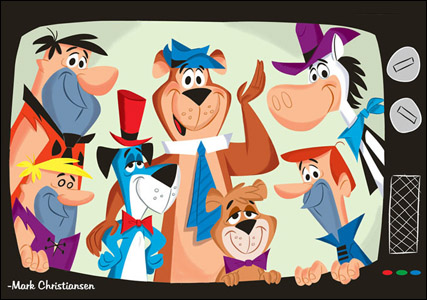
As I said, I liked some of the pieces and just wondered about some others. I suppose that's how an exhibition like this is supposed to work. The piece above by Mark Christiansen was one of the ones I liked. It's his style and he did something special with the characters…but they look like the characters and it looks like he likes the characters. You can view many of the pieces over on this webpage. Don't miss Bill Morrison's.
The way it worked was that from 4 PM to 6 PM, there was a V.I.P. type reception and at six, the doors opened to the general public. I got there around 4:30 and had a good time talking with June Foray, Jerry Eisenberg, Willie Ito, Scott Shaw!, Sam Register, Tony Benedict, Margaret Loesch, Sam Ewing, Don Jurwich, Dave Nimitz, Rose Marie, Stu Shostak and Jeanine Kasun, Jerry Beck, Janet Waldo and why did I start listing names since I'll be leaving so many out? The place was cramped and a lot of us alleged V.I.P.s fled well before six. Stu, Jeanine, Rose and I (and Rose's wonderful caregiver) retired to a nearby Italian restaurant for chow, then I tried to go back after we ate. By then, it was 6:45 and there was a mob scene outside — a line around the block to get in.
No, to be more accurate: A line around the block to get near. I could not even get past the place to get to my car and I had to circle around another way. The Van Eaton folks did a great job promoting the evening but I'd give some of the credit to Huck, Yogi, Fred and the gang. Those characters are still popular, still beloved by many.
I don't know that everyone at Time-Warner understands that and I think some of them are too quick to think the properties require total makeovers to appeal to that most elusive of target audiences, "The Kids Today." I think a lot of them would be better served not by rethinking the original concept but by figuring out how to apply that concept to the current world and audience. You kind of have to ask yourself, "Why was this character popular in the first place?" and then try to keep the answer to that question relatively intact while you change other things around it.
I have a little tirade I should probably write here about what happens to great properties and characters owned by very large corporations. There's a healthy way to handle them and an unhealthy way and the latter kicks in when there's no one person who has either the business authority or the moral authority to say, "No, this is not right for this character." But that tirade will have to wait 'til I have more time. For now, thanks to the Van Eaton Gallery for hosting such a fun event and congrats on its success.
Who Polices the (Fashion) Police?
There's a very popular TV show on the E! network called Fashion Police and its writers are going to court over money they believe they're owed. A lot of money. Here's a link to a report on it. And when you read it, take note of this line: "Writers Guild of America, West has provided legal assistance to the writers in their filings."
This is not a WGA show. E! is not a signatory and the folks who write their shows do so without any protection from a union or other labor organization. When they're screwed, as is alleged here, they have no recourse but to go hire a lawyer. This can be a costly thing, especially when going up against an entity that has a lot more money than you do…which is probably all of them.
I don't know the specifics of the Fashion Police situation beyond what's claimed in the article but it's no secret that writers on non-union shows are often paid poorly. You wouldn't believe how poorly in some cases. And in 100% of the horror stories I've heard, it works like this: The writer is offered bad money. He knows it's bad money but he also knows…
- Hey, it beats not making anything or working at Olive Garden…
- It could lead to something bigger and better and…
- It's only 40 hours a week so I'll have time to work on my own scripts and finding a better position.
"A" is usually true. "B" is occasionally true. Other times, working for low money types you as someone who'll work cheap…or can't be that good if he or she is willing to work for that kind of moola.
"C" seems to never be true. Every single TV staff job turns out to require between 150% and 200% of the time you thought it would when you accepted it — and for the same paycheck. That seems to be the kind of thing that prompted the Fashion Police writers to take action. Most writers do not object because they fear it'll cost them "A" and they'll get typed as troublemakers, thereby scotching "B." It can also cost a lot of money — money they don't have — and it often is not cost effective.
Unscrupulous producers have been known to count on that. There's a guy in town who makes low budget movies who's notorious this way. He agrees to pay you $500 and when the check comes, invariably a few months later than promised, it's for $460…and all your protests and complaints fall on the deafest of ears. He may even shrug and tell you, "If you don't like it, the door is that way," end of discussion. He figures you're not going to quit and go hire a lawyer over $40, nor will any attorney handle your case on contingency for a cut of that. You could take him to Small Claims Court and I understand at least one person did…but most of the time, no one does. Too much trouble…and they need the work.
There's also often a "D" at work here, a tidy bit of self-entrapment: You tell all your friends, "I'm going to L.A. to become a TV writer," and move out here you do. You have in mind writing for prime-time, prestigious shows but, sad to say, there are X openings on those programs and 100X (at least) writers who want those gigs. So you don't get one and then you don't get one and after a while, you still don't get one…and any kind of TV writing job can look mighty appealing. You need the bucks — but more important in some ways is that you need to tell the folks back home that you're writing for television. Any kind of television. If you're wise, you'll do what you can to minimize that kind of pressure.
As for being swindled on money…well, in the 4+ decades I've been a professional writer, I've been swindled on comic book work, swindled on magazine work and swindled on animation work. I've never been swindled on a WGA show. They tend to not cheat you on those because they know you won't have to spend money to take action. The Guild handles things for you.
I am not suggesting that anyone refuse to work on non-WGA live-action shows. That's a decision everyone has to make for themselves. I will suggest that if they do, they not be surprised that they're suddenly working 80 hours and being paid for 40. That happens way too often. I'm glad my Guild is helping these folks.
People Walk on Penn & Teller
Penn & Teller received a star on the Hollywood Walk of Fame yesterday. In case you've never been to one of these ceremonies, there's a video you can go watch…and they all go pretty much like this. If you want to go to one, keep an eye on this page for announcements. The festivities generally start around 11:30 AM and run for about half an hour, give or take ten minutes. There are no tickets and there's no seating. Just arrive early and take your place behind the rope line to watch.
Today's Video Link
My, the musical Wicked looked a lot different when it got to Finland…
More About Carmine Infantino
Carmine Infantino is, quite rightly, being mourned across the Internet — everywhere lovers of great comic art lurk. I suspect he would not be happy with a lot of the obits in that they speak of him as a great illustrator (which he was) but say little if anything about his years as editorial director and then publisher of DC Comics. I didn't have much contact with him the last decade or three of his life but when I was around him, he'd say things like, "There are a lot of good artists around, including many who are better than I ever was. I was the only one who went on to running a big company like DC." That may be true. Other artists moved into management but I can't think of another one who ever had the title of Publisher, at least not of a company anywhere near as big as his. [UPDATE, added a few hours later: Marv Wolfman reminds me that Jim Lee now has the title of co-publisher at DC. Yeah, but that's now and he's co-publisher.]
Some of the obits are making the usual, understandable mistake of giving him sole credit as the creator of comic books and characters that he actually co-created with writers. Deadman, for example, was not created by Carmine Infantino. It was created by Arnold Drake and Carmine Infantino. The Hollywood Reporter even said he'd "introduced" the concept of Earth-Two into the DC line. Translation: He drew the script in which Gardner Fox, working with editor Julius Schwartz, came up with it.
And a few are buying his more grandiose claims of creating Bat Lash, Kamandi and a few others where his input was from all accounts but his, microscopic. I was actually in the room for most of the creation of Kamandi and I wrote up the presentation and first issue plot synopsis based on Jack Kirby's ideas — and they were Jack Kirby's ideas. Carmine asked Jack to give him something similar to Planet of the Apes, Jack hauled out an unsold newspaper strip he'd done in the fifties called Kamandi of the Caves and proceeded to alter it to suit Infantino's request. To put it in starker terms: I contributed more to the creation of Kamandi than Carmine Infantino and I sure don't deserve even a scintilla of the creator credit. Carmine was the kind of guy who had enough impressive credits that it's not necessary to give him someone else's.
Since Infantino the Publisher is being neglected in the stampede to salute Infantino the Artist, let me say a little more about the former. When he eased into power at DC, Infantino took command of a ship that was heading in no intentional direction. "Down" was the prevailing one and no one around had any idea how to get anyplace else. There had been a recent corporate takeover and way too many of the rules were new. The company needed fresh ideas but it had this track record of almost punishing those who'd given them fresh ideas in the past. It wasn't just that Jerry Siegel and Joe Shuster didn't share in the revenues of Superman or receive credit. It was almost like Jerry and Joe had to be flogged as a warning to others who might create something successful and then express dissatisfaction with their share.
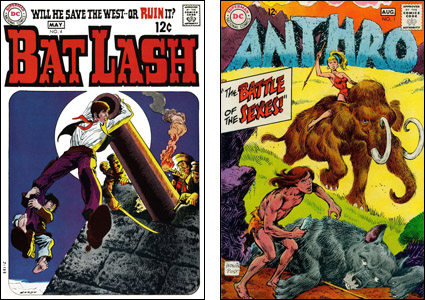
That was far from the only problem. The kind of old-line newsstand that carried comic books was going away in the late sixties. Those that remained cut back on their comic displays, the better to offer Playboy and Penthouse, which between them sold around ten million high-priced copies per month and spawned countless imitators. Newsstands thus were no longer a natural place for kids to hang out. Some even discouraged it because that made it easier to sell soft porn when few minors were about. In the meantime, DC's distributor, Independent News, distributed Playboy and Penthouse and was naturally more interested in them than in Action Comics. Every month, a smaller and smaller percentage of what DC printed was available for purchase. In some areas, you could walk for miles and not find the new comics.
So that was the company Infantino inherited: His creators were discouraged from creating and his distributors didn't want to distribute. Oh, yes — and the cost of printing was going up. Comics were 12 cents when he took power. Then before long, they were 15. Soon, it became time to raise prices yet again. DC went to a very unappealing package — a mix of new material backed up by reprints that just felt like padding — for 25 cents. Marvel tried it for one month, then went back to the old size for twenty cents — which in light of DC's 66% price hike didn't seem so awful. For a year or so until they gave up and went to 20, DC got clobbered and it was some time after Infantino was ousted that the company fully recovered from that experiment.
Infantino always insisted he was not responsible for that failed strategy and he certainly didn't cause the distribution crisis. He might have been able to make the company more creator-friendly but maybe not…and even with that impediment, he managed to come up with some pretty good books. What he couldn't seem to do was to keep them running long enough to find an audience. The minute it was clear or even suspected something new wasn't selling as well as Batman, it was terminated. A few comics were even, quite literally, cancelled before there were any sales figures in on them at all and there were rumors in the office that numbers that did come in were sometimes being misread or misreported. Whatever the truth was, readers learned not to fall in love with anything new from DC because, you know, the odds were good it would be gone soon. That was another problem that took a long time to go away.
A lot of those books were terrific. True, Green Lantern/Green Arrow by O'Neil and Adams only lasted fourteen issues but with a different man in charge, it might not have existed at all. Give him credit for that. Give him credit for helping move comics into a new era by among other things, treating covers as intended works of art rather than copy-heavy sales pieces. Give him credit for all the new careers that were launched during his time in charge. And a lot of comics that were considered flops during his regime — considered that by him as well as others — are still with us, some reprinted time and again in expensive hardcover editions with their characters turning up in other media and current comics. Time-Warner is now making a lot of money off some of Carmine's "failures."
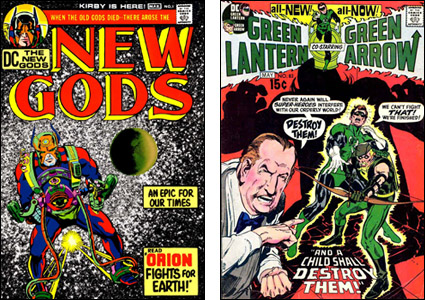
For several years running, Infantino flew out for the big Comic-Con in San Diego. Few professionals did then and of course, since he was an artist we all loved and the Head of DC, he was a very big deal, indeed. Each year, he would make a speech touting the great, sure-to-revolutionize-the-field new comics DC was about to bring out. Each year, he would deftly avoid mentioning that all of the previous year's great, sure-to-revolutionize-the-field new comics were either cancelled or about to be. I still think some of them would have caught on big if they'd been given more of a chance. Marvel's concurrent Conan the Barbarian comic debuted to sales lower than some of the DC innovations that Carmine quickly axed but Marvel kept Conan running (and published monthly, unlike most new books DC introduced) until it found an audience and paid off big for them.
One evening at one con, I dined with him and Mr. and Mrs. Jack Kirby in the hotel's semi-swank dining room. Fans kept interrupting the dining to ask for autographs or quick sketches and it went like this: Someone would approach and tell Kirby how much he or she loved New Gods, Fantastic Four and/or the Silver Surfer. Jack would say thank you. The person would then tell Infantino how much he or she loved The Flash, Adam Strange or the Batman comics he drew. Carmine would say thank you and then remind the person that he didn't do that anymore; that he was now the publisher of DC Comics and, oh, wait'll you see this great new book that's about to come out.
Jack didn't do quick sketches. He wasn't good at them and there were other issues relating to how when he did them, they always seemed to turn up on some dealers' table being sold before the ink was dry. But Carmine did quick sketches and he was amazing at them. "Whadda ya want?" he'd ask the fan — and if the fan said "Adam Strange," a lovely profile shot would appear after the kid said "Adam" but before he got the "Strange" part out. If the fan was really smart, he'd ask for the obscure character, Detective Chimp, which Carmine always said was his favorite. He'd take more time and care drawing Detective Chimp. He'd spend, like, five seconds instead of the three it took him (appropriately enough) to draw The Flash.
At one point after that meal, I found myself alone with Carmine and I kidded him that he was slowing down: "That Batman you did for that kid took you almost four seconds." He chuckled and I said, "I hope you take it as a compliment when guys like me tell you how much we miss seeing you actually draw comics." He said he did…then he added, "I sometimes miss it too. It was so simple. I mean, I struggled with a lot of pages and did some over and over again to get them right…but I didn't have to deal with all the pricks upstairs and down the hall." I believe the pricks upstairs were his corporate overlords and the ones down the hall were Independent News. I don't think any of them intentionally sabotaged what he was trying to do but they couldn't have done a much more effective job if that had been their intention. And they had a lot of help…from him.
He went on to talk of how when he drew comics, he at least knew pretty much how to do that. Working the business side of things — dealing with numbers and sell-throughs and printing contracts and licensing deals — it was all so frustrating. I believe that was the word he used: Frustrating. Did I detect a bit of longing to go back to the easier, more appropriate, I thought, job description? Just for a second, I believe I did…but he knew what I was thinking and quickly set me straight: No, absolutely not. An executive he was now and an executive he would stay. He stayed one for about three more years before they called him in and told him he was no longer one, at least in their building.
Hearts broke for him across the industry, mine included, when they told him that. I don't think he was suited for that job but he was so very, very proud of it. And besides, I'm not sure there even was anyone then good enough at publishing to stop DC Comics from crashing into icebergs. It certainly wasn't possible to be as good a publisher as Carmine Infantino was an artist. When he was at the drawing board…ah, that's when he could really work magic. Just take a look at every single thing he did while in his prime.
Set the TiVo!
A new season of Michael Feinstein's American Songbook debuts this weekend on PBS. Consult, as we say in the TV business, your local listings.
And for those of you who live in Los Angeles: Tuesday evening at 7:30 PM, KCET (Channel 28) is rerunning an episode of Huell Howser's show in which he toured Forrest J Ackerman's famous home full of s-f and monster stuff. Mr. Howser, who passed away earlier this year, was a jovial man who produced interesting TV programs about people and places he visited. He seemed to like everything he came across and as I recall, he was a lot more impressed by Forry Ackerman and his home than I was when I first visited the original Ackermansion at age 16. But it's well worth DVRing and watching.
Recommended Reading
Like a lot of us who hang out often on the left-hand sector of the political spectrum, I'm not too thrilled this A.M. to read that President Obama is willing to trade cuts in Social Security for other things — and it's not just the fear that Republicans will somehow get all the cuts without giving in on all the other things. I just think this country works better when fewer of its citizens are living in poverty or close to it. I think my feelings are a lot like those of Josh Marshall.